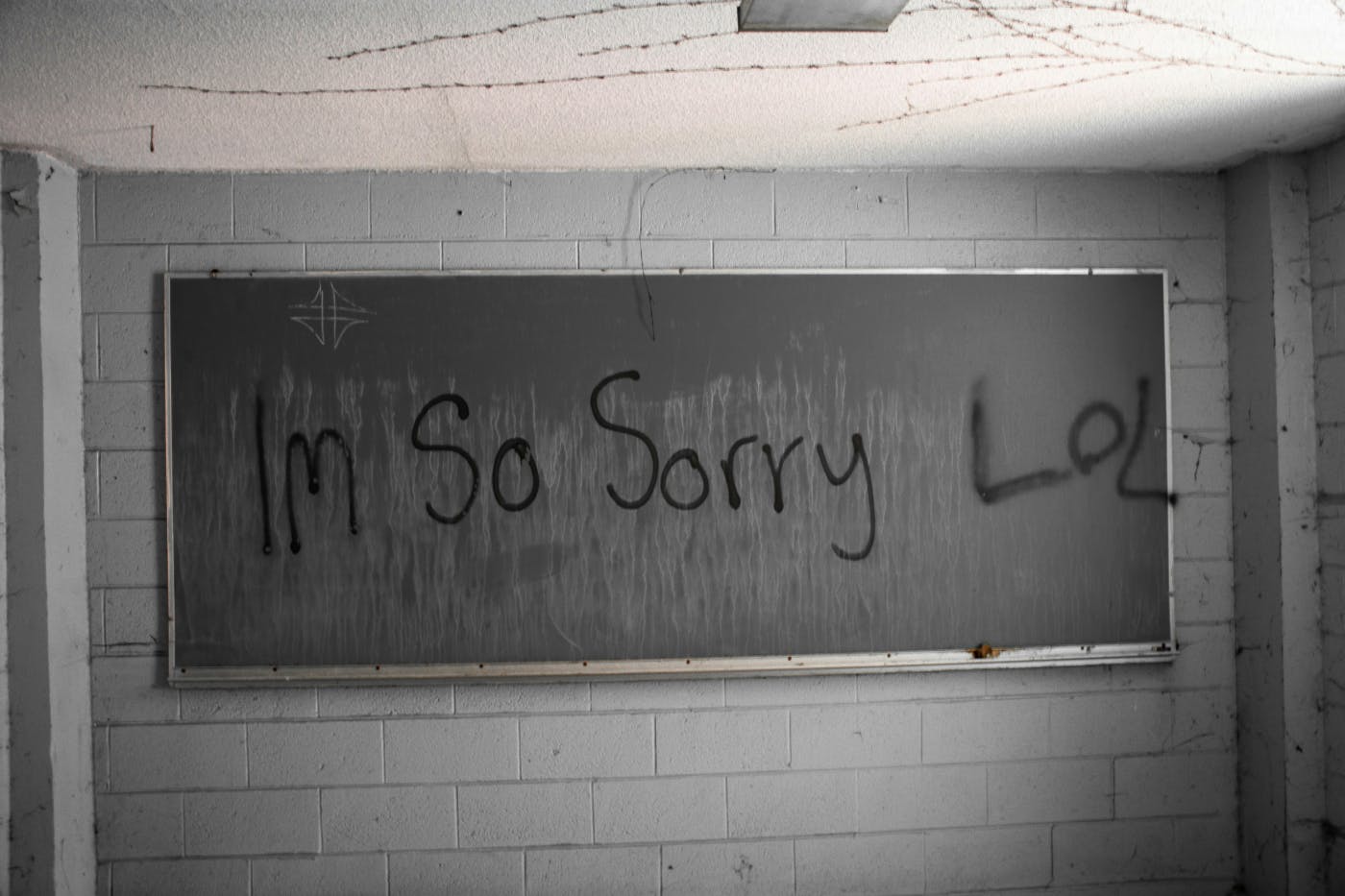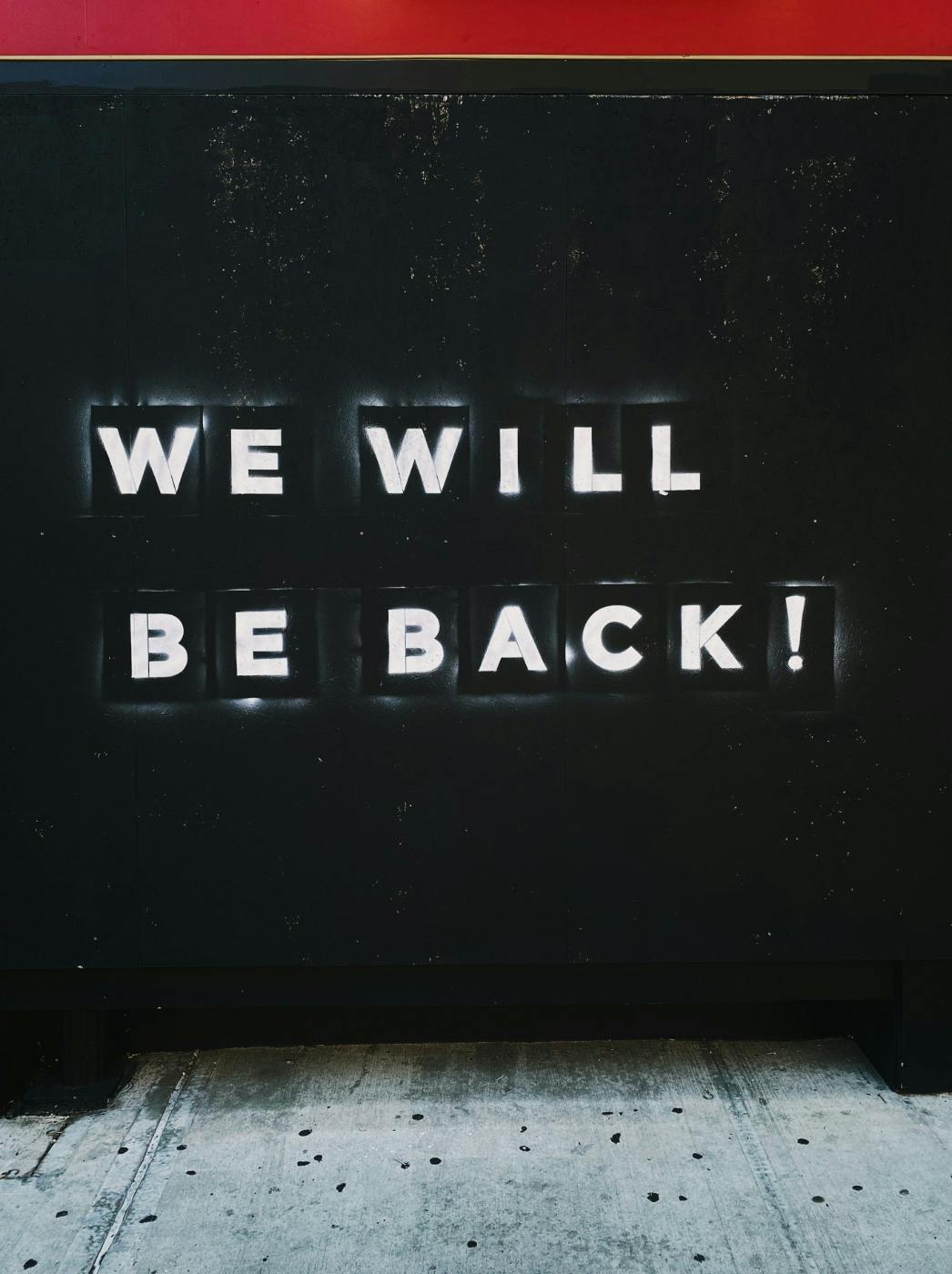
A brand doesn’t have the same luxury as I did in that show. I had 45 more chances, a brand doesn’t. I was just good enough that I was able to recover my show and do a great run, a brand doesn’t have that luxury.
Years ago, I was playing Touchstone in As You Like It, and as he is a melding of the classic clowns and fool, the director called on me to improvise some stuff, which I did. One night during the show, things were going well, and then, for some reason that to this day I have no idea why, I made a joke about the Catholic Church. It made sense; the church was powerful during Shakespeare’s time, and the joke worked in the context of the scene we were playing. I laid the joke out and was met with a stony silence. I moved on.
Trouble is, the audience didn’t.
No matter what I did during that show, the audience was not on my side. I was kinda young, so instead of just laying off and letting the audience react the way they wanted, I started trying to force the humor. I became desperate, and the harder I tried, the further away the audience got.
By the end of the show, I was drenched in flop sweat, the rest of the cast was treating me like my dog had died, and I went to my local and drank the show away and out of my system. Later, I learned that a large group from Catholic Charities had bought tickets for the night, and no one had told me. My clown character, with the freedom to play, had played in the wrong yard. Big mistake. But that wasn’t the real problem. The real problem, as I sensed it the moment I made the church joke, and I didn’t just let it go. Each time I didn't get a laugh that had been there in past shows, I pushed and tried harder. The show got away from me, and I was never able to come back. Thankfully, there were still 45 shows left in the run, and I was able to get it all back the next night.
I was lucky. I had good people around me, older actors who had been where I was, and they helped me through it, and the bad show didn’t stain my reputation.
Like I said, I was lucky; I was able to recover. And, I learned a valuable lesson. This made me think of brands that try too hard, make a major mistake, don't know it, and ruin themselves. Some are lucky enough to rebuild, but some just push and try everything, only to find there is nothing they can do.
A brand doesn’t have the same luxury as I did in that show. I had 45 more chances, a brand doesn’t. I was just good enough that I was able to recover my show and do a great run, a brand doesn’t have that luxury. So, today I want to look at the things brands do that are really wrong, how they recover, and how, sometimes, there is just no going back.

1. Ignoring Customer Feedback
A brand that disregards or downplays customer feedback is setting itself up for failure. Every interaction, whether through social media, reviews, or direct communication, offers an invaluable opportunity to understand what your customers want, need, and expect. When you ignore or dismiss their feedback, you risk severing the emotional connection between your brand and your audience.
Ignoring customer feedback not only alienates your current customer base but also limits growth. Consumers are increasingly vocal about their preferences, and they’re more likely to walk away from brands that fail to evolve based on their needs. Brands that don’t actively engage in listening and adapting to customer insights will inevitably fall behind the competition.
Example: Blockbuster’s downfall is a classic case. The brand ignored the rising demand for digital streaming and the convenience of at-home rentals. While Netflix was learning from customer habits and shifting to a digital model, Blockbuster stayed focused on its physical rental stores and missed the mark on what its customers were looking for. This unwillingness to listen to feedback wasn’t just a missed opportunity; it was a death sentence for the brand.
What to Do Instead:
- Make customer feedback a cornerstone of your brand's evolution. Establish clear channels for customer interaction and actively monitor feedback.
- Address concerns quickly and transparently. Show customers that their voices are heard.
- Regularly analyze feedback trends to identify emerging customer needs and adjust your offerings accordingly.
2. Failing to Define or Stick to a Clear Brand Identity
One of the most significant mistakes a new brand can make is not establishing a strong, consistent identity. A brand's identity is more than just its logo or colors—it's the promise you make to your audience and the personality you project through every interaction, from your website to your social media posts. Without a clear identity, your brand risks blending into the background, unable to differentiate itself from the competition.
A confusing or inconsistent brand identity creates mixed messages, leaving customers unsure of what you stand for. Whether it’s a lack of cohesion in your messaging or constantly shifting your brand’s voice and values, failing to stick to a defined identity can create distrust and diminish loyalty.
Consider brands like Gap, which faced backlash in 2010 for unveiling a new logo without any public input. The new logo, a departure from its iconic design, didn’t fit the brand’s established identity. Customers immediately rejected the change, feeling disconnected from a brand they had trusted for years. The logo was quickly pulled back, and the company had to scramble to restore its reputation. This highlights the importance of not only defining your brand identity but also ensuring that it resonates with your audience and remains consistent.
What to Do Instead:
- Take the time to define your brand’s mission, vision, and values. Your brand identity should reflect your company’s purpose and resonate with your target audience.
- Ensure all brand touchpoints, from your website and product packaging to your social media profiles, align with your identity. Consistency is key.
- Before making any significant changes, such as a logo redesign or brand repositioning, test the waters with your audience. Feedback is vital in these instances to ensure your changes will be well-received.
Failing to create a consistent identity doesn’t just confuse customers—it alienates them. So, if you want your brand to stay top-of-mind and build lasting loyalty, define your identity early, stay true to it, and remain consistent across all channels.
3. Underestimating the Power of Emotional Connection
In today’s market, logic alone doesn’t drive consumer loyalty—emotion does. Brands that fail to connect with their audience on a deeper, emotional level are missing out on a huge opportunity. Whether it’s a sense of community, a shared value, or just the feeling a customer gets when they interact with the brand, emotional connection creates lasting bonds that go beyond the transaction.
Without emotional appeal, your brand is just another product or service in a sea of options. It’s the emotional connection that transforms customers into loyal advocates, driving repeat business, word-of-mouth recommendations, and brand advocacy. If you don’t foster that emotional bond, you risk being forgotten as soon as your customer’s needs change or a competitor makes a more emotional appeal.
One of the best examples of a brand that learned the power of emotional connection is Apple. In the early days, Apple wasn’t just selling computers—it was selling the idea of thinking differently. The brand built its identity around creativity, innovation, and simplicity, which resonated emotionally with its audience. This connection is a big reason why Apple customers remain fiercely loyal, even in a competitive market. On the flip side, Sears, once a retail giant, failed to cultivate any strong emotional connection with its customers. As consumer preferences shifted, Sears’s lack of emotional resonance with its audience contributed to its decline, even as it tried to adapt to digital and e-commerce trends.
What to Do Instead:
- Build your brand’s story around shared values that resonate with your audience. Ask yourself: What does your brand stand for beyond the product?
- Create experiences that emotionally engage your customers, whether through content, community-building, or personalized service.
- Continuously reinforce your emotional connection through customer interactions, marketing campaigns, and brand messaging.
Customers want to feel like they’re part of something meaningful, and when they do, they’re far more likely to become lifelong fans of your brand. Don’t just sell a product—sell an experience that resonates emotionally and creates a deeper connection.
4. Overpromising and Under-Delivering
In the pursuit of attracting new customers, brands sometimes make the mistake of overpromising in their marketing—whether it’s about the quality of their product, the speed of their service, or the level of customer support they offer. While the intention is often to impress potential customers, overhyping your product or service can lead to disaster when you don’t deliver on those lofty claims.
When your customers feel let down or deceived, the damage to your brand’s reputation can be long-lasting. Trust is the bedrock of any brand, and once it's broken, it’s incredibly difficult to repair. Overpromising creates unrealistic expectations, and when those expectations aren’t met, customers feel disappointed, frustrated, or even betrayed.
Take Theranos as a textbook example. The company promised to revolutionize blood testing with a device that would make blood draws faster, cheaper, and more convenient. Unfortunately, the product never delivered, and the company’s claims were proven to be fraudulent. Not only did this lead to the company’s collapse, but it also shattered the trust of everyone involved, from investors to consumers. Overpromising may have helped Theranos gain attention, but it ultimately destroyed the brand.
What to Do Instead:
- Set clear, realistic expectations from the get-go. If your product or service isn’t perfect, be upfront about it and focus on how it can improve over time.
- Ensure your marketing is aligned with your actual capabilities. Avoid making exaggerated claims that you can’t back up.
- Under-promise and over-deliver. It's far better to exceed expectations than to fall short of them.
Customers want transparency, not hype. They’re more likely to return to a brand that delivers on its promises—even if those promises are modest—than one that leads them to believe it’s something it’s not.
5. Failing to Adapt to Market Changes
In the world of business, change is the only constant. Brands that don’t adapt to evolving market trends, consumer preferences, or technological advancements are setting themselves up for obsolescence. The ability to pivot when necessary is key to long-term survival.
Brands that fail to recognize these shifts—or worse, resist them—often find themselves left behind. Whether it's an emerging competitor, new technology, or changes in consumer behavior, failing to stay relevant can have disastrous consequences.
Example: Blackberry is a classic case. Once a dominant player in the mobile phone market, Blackberry didn’t anticipate the consumer shift toward touchscreen smartphones and the rise of app-based ecosystems. While Apple and Android quickly adapted, Blackberry stuck to its keyboard-based phones, ultimately losing its dominant position and almost vanishing from the market entirely.
What to Do Instead:
- Continuously monitor industry trends and listen to customer feedback. This will help you stay ahead of the curve and anticipate market changes.
- Build a flexible strategy that allows for adjustments when necessary. Being adaptable will help you seize new opportunities when they arise.
- Stay connected to your audience’s evolving needs and preferences, and be ready to adjust your offerings to stay relevant.
Being proactive rather than reactive can give your brand a significant edge over competitors. When you’re able to anticipate changes and adapt quickly, you’ll position yourself as a leader, not a follower.

6. Overlooking the Importance of Customer Service
In the digital age, customer service can make or break a brand. Customers expect quick, helpful, and courteous service, whether they’re reaching out through email, social media, or over the phone. Brands that fail to prioritize customer service risk damaging their reputation and losing customers for good.
Poor customer service is one of the most immediate ways to ruin the trust you’ve worked so hard to build. Suppose a customer feels ignored, disrespected, or dissatisfied with the resolution to their issue. In that case, they’re likely to share their experience—and in today’s world, that can mean a viral social media post or a bad review that reaches a wide audience.
Take United Airlines as a case study. The infamous incident in 2017, when a passenger was dragged off a flight to make room for crew members, sparked widespread outrage and negatively impacted the airline’s brand for years. It wasn’t just the physical altercation that made headlines—it was United’s initial poor response, which only fueled the fire. The incident showed just how devastating bad customer service can be, especially when the brand mishandles a crisis.
What to Do Instead:
- Invest in your customer service team. Ensure they are well-trained, empowered to solve problems, and capable of representing your brand positively.
- Respond quickly and empathetically to customer complaints, especially on social media. Transparency and genuine concern can go a long way in repairing relationships.
- Offer multiple channels for customers to reach you, whether it’s through live chat, email, social media, or even in-person support.
Good customer service isn’t just about handling complaints—it’s about building long-term relationships with your customers. When you make them feel valued, they’re more likely to come back, and even more likely to recommend you to others.
7. Neglecting to Build a Strong Online Presence
In today’s digital-first world, a brand without a robust online presence is at a serious disadvantage. Whether you’re a new brand or an established one, your online presence is often the first touchpoint customers have with you. It’s where they’ll form their first impression, engage with your content, and, ultimately, decide whether to buy from you. Neglecting this space is a missed opportunity to connect with your audience and grow your business.
From a sleek, user-friendly website to active and engaging social media channels, your online presence should reflect the values of your brand and foster trust with your audience. If your website is outdated, difficult to navigate, or lacks essential information, potential customers will likely bounce, and they might not come back.
Example: Sears provides another cautionary tale. While they were once a retail giant, their failure to keep up with the rise of e-commerce and adapt their online shopping experience contributed to their downfall. Competitors like Amazon invested heavily in their online presence, making it easier for consumers to shop from anywhere. By failing to prioritize their digital transformation, Sears missed out on a massive market shift and ultimately couldn’t compete.
What to Do Instead:
- Invest in a user-friendly, mobile-responsive website. Ensure it’s easy for customers to navigate and find the information they need quickly.
- Leverage social media platforms to engage with your audience and create a community around your brand. Regularly post content that aligns with your brand values.
- Optimize your online presence for search engines (SEO). A great website and active social media channels won’t help if no one can find you online.
Building a strong online presence is no longer optional—it’s essential for survival. If you want to stay relevant and grow your audience, you need to meet your customers where they are: online.
8. Not Having a Crisis Management Plan
Every brand, no matter how successful, will face a crisis at some point. Whether it’s a product recall, a PR disaster, or a social media backlash, how you handle the situation can make or break your brand. Brands that don’t have a crisis management plan in place are more likely to flounder when things go wrong, resulting in prolonged damage to their reputation and customer trust.
When a crisis hits, the key to survival is a well-prepared, coordinated response. Brands that panic or respond in an unorganized manner tend to make the situation worse. A reactive approach creates confusion and a lack of accountability, which can escalate the problem. On the other hand, a brand with a crisis management plan that includes clear protocols and preemptive strategies is far better equipped to weather the storm.
Consider the 2018 Nike controversy surrounding the Colin Kaepernick ad campaign. While some were outraged, Nike stood by its decision, maintaining a clear, unified message. Their response was swift, and they stuck to their values, leading to an increase in sales and brand loyalty. This wasn’t a happy accident; Nike had a well-thought-out crisis communication strategy that they executed flawlessly.
What to Do Instead:
- Develop a comprehensive crisis management plan before a crisis hits. Identify potential risks, assign roles to team members, and prepare responses for a variety of scenarios.
- Be transparent, take responsibility, and show empathy during a crisis. Your customers want to see that you care about the situation and are taking steps to fix it.
- Keep your messaging consistent across all channels. A coordinated response shows strength and leadership in the face of adversity.
A well-prepared crisis management plan can help your brand not just survive a crisis, but even thrive by showing that you're responsible and capable under pressure.
9. Relying Too Heavily on Trends
Trends can be tempting. They offer a quick way to gain attention, increase sales, and align your brand with something current or popular. But relying too heavily on trends can be a dangerous game, especially if they don't align with your brand’s core values or long-term strategy.
Brands that jump on every trending bandwagon risk appearing inauthentic or opportunistic. If your brand doesn't genuinely connect with the trend or it feels forced, customers will quickly see through it. Additionally, trends are fleeting—what’s popular today may be forgotten tomorrow, leaving your brand looking outdated and disconnected when the trend passes.
Example: Pepsi’s 2017 ad featuring Kendall Jenner is a prime example of trend-chasing gone wrong. The ad tried to tie Pepsi to social justice movements, but the tone-deaf approach and the brand’s lack of a genuine connection to the cause sparked outrage. Instead of aligning with the broader movement, it seemed like Pepsi was merely cashing in on a social trend, leading to massive backlash and an apology.
What to Do Instead:
- Stay true to your brand’s core values and mission. While it’s okay to tap into trends that align with your identity, don’t let them dictate your brand’s direction.
- Avoid using trends as a quick fix for deeper, long-term brand issues. Trends are a tool, not a strategy.
- If you do participate in trends, ensure they fit naturally into your brand narrative and resonate with your audience in a meaningful way.
Trends can be useful for gaining attention, but they shouldn’t define your brand. Stay focused on what your brand stands for and be mindful of how trends align with your values to avoid looking opportunistic or inauthentic.
10. Ignoring the Importance of Brand Consistency Across Channels
Brand consistency is key to building trust and recognition with your audience. When a brand presents itself differently across channels—whether through inconsistent messaging, visuals, or tone—it sends mixed signals to consumers. Over time, this inconsistency can undermine customer loyalty and make it harder for your brand to be remembered or taken seriously.
Inconsistent branding creates confusion, and confusion leads to a lack of trust. If your messaging on social media differs drastically from your website or product packaging, customers may start to wonder what your brand actually stands for. In today’s competitive market, where attention spans are short and options are plentiful, consistency is vital for maintaining a strong brand presence.
Example: Yahoo struggled with brand inconsistency over the years, which ultimately contributed to its decline. The company’s branding often felt disjointed, as it switched between various visual styles and messaging without a clear focus. While Yahoo was once a dominant force in the digital space, its lack of consistent brand messaging across platforms and products left consumers confused and unable to identify what Yahoo truly stood for. This inconsistency hurt its ability to compete with more focused, consistent brands like Google.
What to Do Instead:
- Ensure that your brand’s voice, visuals, and messaging are consistent across all channels. From your website to your social media pages, your brand should have a unified look and feel.
- Develop clear brand guidelines to ensure all team members and partners understand your brand’s voice and visual style.
- Regularly audit your brand presence across all platforms to ensure consistency. Inconsistencies can creep in over time, so stay vigilant.
A consistent brand presence builds trust and makes it easier for customers to recognize and remember you. If your brand isn’t sending a clear, unified message, you’re missing a critical opportunity to build lasting relationships with your audience.

The Big Comeback: A Brand That Recovered from the Brink
Sometimes, the greatest success stories are born from the biggest mistakes. Brands that seemingly made catastrophic errors but managed to recover prove that it's not always about avoiding missteps—it’s about how you handle them when they happen.
Example: Nike is a perfect example of a brand that turned a potential disaster into a triumph. In the early 2000s, Nike faced serious backlash for its use of sweatshops and labor issues in countries like Indonesia and China. The negative press and public outrage could have easily destroyed the brand, but Nike responded in a bold and proactive way. They made significant changes to their labor practices, became transparent about the steps they were taking to improve, and even launched a campaign focused on their new approach to ethics in manufacturing. The result? Nike not only survived the crisis but also emerged as a more socially responsible brand, strengthening their connection with customers who valued their transparency and commitment to improvement.
Nike’s ability to own their mistakes, learn from them, and evolve in the face of public scrutiny transformed a potential downfall into a powerful comeback. They didn’t just recover—they came out stronger, with a renewed brand identity focused on transparency, social responsibility, and innovation.
The Takeaway:
No brand is perfect. Mistakes will happen, but the true test of a brand’s resilience lies in its ability to acknowledge its failures, learn from them, and make meaningful changes. If you handle your mistakes with honesty, transparency, and a clear plan for improvement, you’ll not only survive the storm, you’ll come out stronger on the other side.
Summing Up
Brands, like people, make mistakes. But it’s how you bounce back that defines you. From ignoring customer feedback to failing to adapt, we’ve seen how brands can fall into traps that damage their reputation. However, as we've seen through examples like Nike’s remarkable comeback, the right response to a mistake—acknowledging it, learning from it, and making meaningful changes—can lead to a stronger, more resilient brand.
At ThoughtLab, we believe in the power of reflection and growth. We help brands navigate the highs and lows of their journeys, ensuring that mistakes become opportunities for transformation. Every brand can thrive, even after making a misstep—what matters most is how you approach your recovery and how you build from there. So, take this guide as a roadmap, and remember: the greatest brands are often the ones that turn their mistakes into their most powerful stories.

